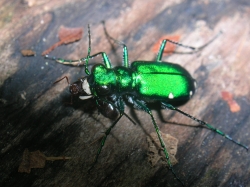
showing loose sides that slide victims
to awaiting jaws at the bottom
Courtesy & Copyright,
Jim Cane, Photographer

Licensed under
GNU Free Documentation License
Lions and tigers in Utah. Oh my! But fear not unless you are an insect. Ant lions and tiger beetles are fierce, diminutive predators. They are not related to each other and the adults look very different, but the larval stages behave in very similar ways. Both await their prey in earthen lairs.
The conical pits of antlions are found in dry, soft sand, frequently under trees, rock overhangs or house eaves. The larvae dig their pit by crawling backwards in a spiral, plowing with their abdomen. The slope of the sides reaches the angle of repose, which is the steepest angle that the sand can lie before it collapses from a slight disturbance. They embed themselves in the sand at the bottom of the pit with their enormous mandibles open like a bear trap. Any small insect that inadvertently steps over the edge of the pit will tumble to the bottom into waiting jaws.
Tiger beetle larvae also await their prey in a burrow, but theirs is a narrow cylinder. The adult female inserts her eggs in the soil. The young larva uses its formidable mandibles to loosen the surrounding dirt, pushing it to the surface with its head and thorax. The larva’s lower back has a prominent hump with two pairs of large hooks. With these, it anchors itself to the burrow wall, its mandibles poised at soil level. Woe to the insect that walks nearby.
The adults of these two underground predators differ in both appearance and lifestyle. The adult antlion resembles a damsel fly with two pairs of long, transparent wings and a weak, nocturnal flight. The adult does not feed and only lives about 3 weeks. Conversely, the diurnal adult tiger beetle is an aggressive, mobile predator. For its size, it is the fastest running insect. It runs so quickly that it cannot see its prey, so sprints and stops repeatedly to track its intended victim. Tiger beetles come in diverse colors and patterns including bright, iridescent greens and blues. In Utah, look for them on bare ground, such as trails in open country or on dunes.
This is Linda Kervin for Bridgerland Audubon Society.
Credits:
Images: Courtesy and Copyright Jim Cane
And Courtesy Wikimedia
Theme: Courtesy & Copyright Don Anderson Leaping Lulu
Text & Voice: Linda Kervin, Bridgerland Audubon Society
Additional Reading:
Other Wild About Utah Pieces by Linda Kervin
Tiger Beetles:
https://askabiologist.asu.edu/explore/chasing-tiny-tigers
A field guide to the tiger beetles of the United States and Canada [electronic resource] : identification, natural history, and distribution of the Cicindelidae / David L. Pearson, C. Barry Knisley, and Charles J. Kazilek New York : Oxford University Press, 2005. (via Amazon) https://www.amazon.com/Field-Beetles-United-States-Canada/dp/0199367175/
https://en.wikipedia.org/wiki/Tiger_beetle
Antlions:
https://bugguide.net/node/view/137
https://www2.palomar.edu/users/warmstrong/pljuly97.htm
